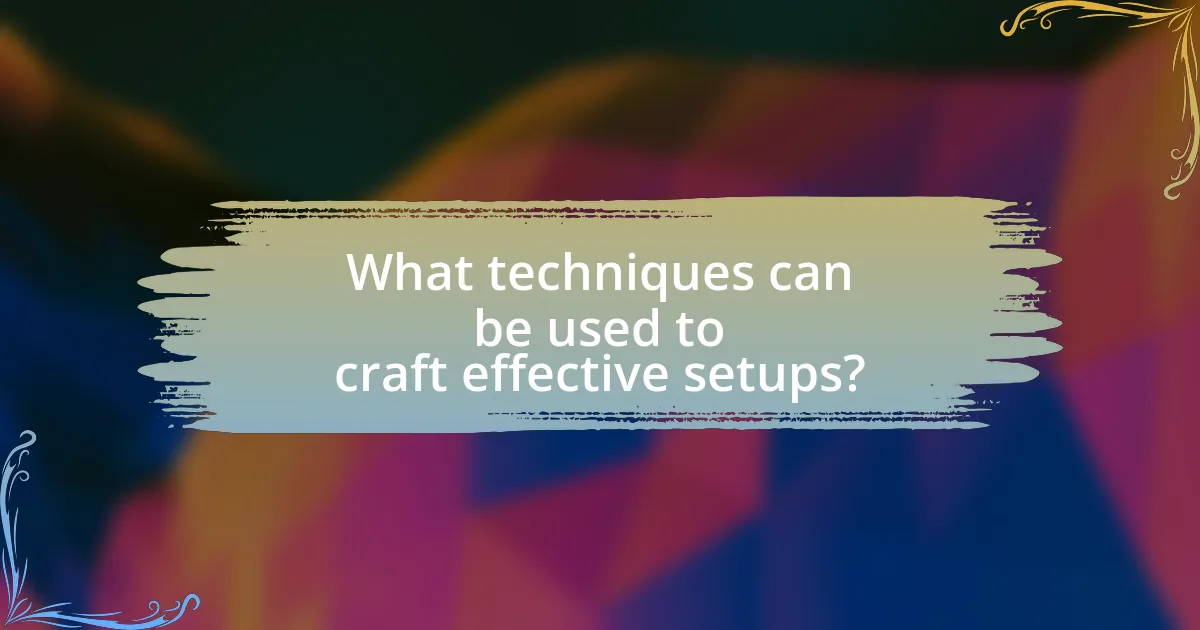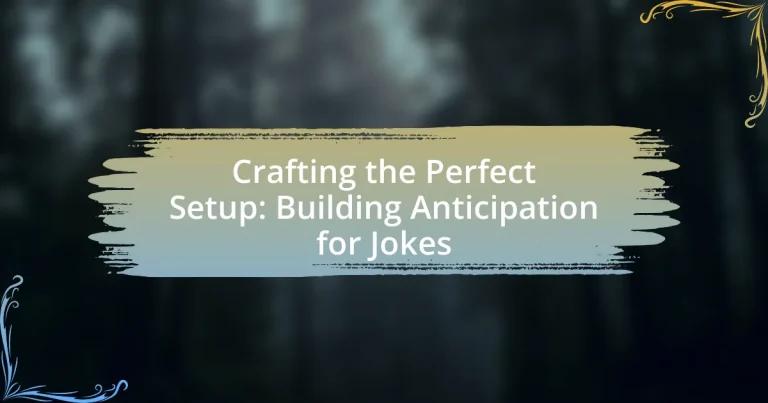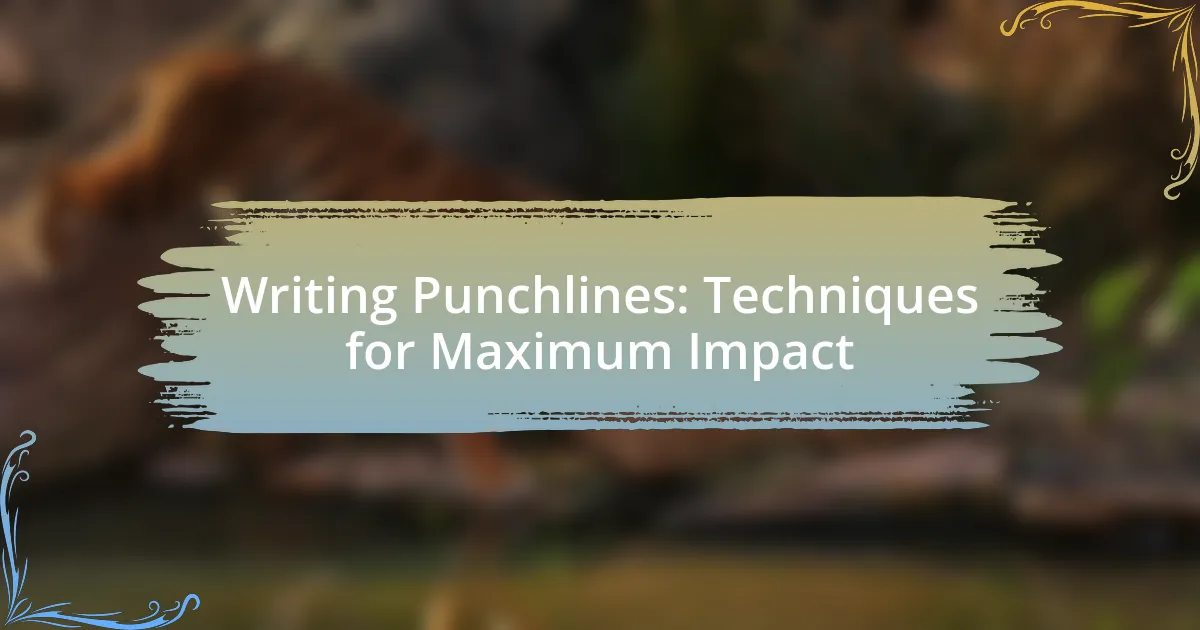Crafting the perfect setup for jokes is essential for building anticipation and enhancing the comedic effect. This article explores the significance of a well-structured setup, which includes key elements such as context, misdirection, and timing. It examines how anticipation influences audience engagement and the psychological principles underlying humor, particularly the role of incongruity. Additionally, the article outlines techniques for creating effective setups, common pitfalls to avoid, and strategies for refining joke delivery through practice and feedback. Overall, it provides a comprehensive guide to maximizing the impact of humor through effective setup crafting.

What is Crafting the Perfect Setup for Jokes?
Crafting the perfect setup for jokes involves creating a context that builds anticipation and primes the audience for the punchline. A well-structured setup typically includes a relatable scenario or premise that engages the audience’s attention and establishes a framework for humor. For instance, effective setups often utilize misdirection or incongruity, leading the audience to expect one outcome while delivering another, thus enhancing the comedic effect. Research in humor theory, such as the Incongruity Theory, supports this approach by highlighting that humor arises from the unexpected resolution of a setup.
How does the setup influence the effectiveness of a joke?
The setup significantly influences the effectiveness of a joke by establishing context and creating anticipation. A well-crafted setup primes the audience for the punchline, guiding their expectations and enhancing the surprise element when the punchline is delivered. Research indicates that the cognitive process of humor relies on incongruity, where the setup leads the audience to anticipate a certain outcome, and the punchline subverts that expectation. This mechanism is supported by studies in psychology, such as those by Martin et al. (2003), which demonstrate that effective setups increase the likelihood of laughter by engaging the audience’s cognitive and emotional responses.
What are the key elements of a successful joke setup?
A successful joke setup includes three key elements: context, misdirection, and timing. Context establishes the scenario or situation, allowing the audience to relate to the setup. Misdirection introduces an unexpected twist, leading the audience to anticipate one outcome while preparing for another. Timing is crucial, as the delivery pace can enhance the punchline’s impact. Research indicates that effective setups create cognitive dissonance, which primes the audience for humor, making these elements essential for maximizing comedic effect.
How does timing play a role in building anticipation?
Timing is crucial in building anticipation because it dictates when the audience receives information, influencing their emotional response. In the context of jokes, effective timing allows the setup to create a buildup of expectation, making the punchline more impactful. Research indicates that well-timed pauses can enhance suspense, as demonstrated in studies on comedic delivery, where comedians who strategically timed their setups achieved higher audience engagement and laughter rates. This illustrates that the interval between the setup and the punchline is essential for maximizing the comedic effect, thereby validating the importance of timing in anticipation.
Why is anticipation important in joke telling?
Anticipation is crucial in joke telling because it creates a buildup that enhances the impact of the punchline. When a comedian sets up a joke, they provide context and lead the audience to expect a certain outcome, which heightens the surprise and humor when the punchline deviates from those expectations. Research in psychology indicates that humor often relies on incongruity, where the brain experiences a mismatch between what is anticipated and what is delivered, resulting in laughter. This principle is supported by studies such as those conducted by the University of California, which found that effective joke structures utilize anticipation to maximize comedic effect.
How does anticipation affect audience engagement?
Anticipation significantly enhances audience engagement by creating a heightened sense of expectation and emotional investment. When an audience anticipates a punchline or a twist in a joke, their focus intensifies, leading to increased attentiveness and responsiveness. Research indicates that anticipation activates the brain’s reward system, making the eventual payoff more satisfying and memorable. For instance, a study published in the journal “Cognition” by researchers at the University of California found that participants who experienced anticipation before a humorous reveal reported higher enjoyment levels compared to those who did not. This demonstrates that effectively building anticipation can lead to a more engaged and responsive audience.
What psychological principles underlie the anticipation in humor?
Anticipation in humor is primarily underpinned by the psychological principles of incongruity and surprise. Incongruity theory posits that humor arises when there is a discrepancy between what is expected and what actually occurs, creating a cognitive shift that elicits laughter. This principle is supported by research indicating that humor often relies on the violation of social norms or logical expectations, prompting a mental re-evaluation of the situation. Additionally, the element of surprise enhances the comedic effect, as unexpected outcomes trigger a release of tension, leading to amusement. Studies have shown that the timing and delivery of a joke significantly influence the effectiveness of this anticipation, reinforcing the importance of setup in crafting humor.

What techniques can be used to craft effective setups?
Effective setups for jokes can be crafted using techniques such as misdirection, establishing a relatable context, and employing a strong punchline contrast. Misdirection involves leading the audience to expect one outcome while delivering an unexpected twist, which enhances humor. Establishing a relatable context allows the audience to connect with the setup, making the punchline more impactful. Additionally, a strong contrast between the setup and punchline heightens the comedic effect, as seen in classic joke structures where the setup builds a specific expectation that the punchline subverts. These techniques are supported by comedic theory, which emphasizes the importance of surprise and relatability in humor.
How can word choice enhance the setup of a joke?
Word choice enhances the setup of a joke by creating vivid imagery and establishing context that primes the audience for humor. Specific language can evoke emotions, set a tone, and build anticipation, making the punchline more impactful. For example, using unexpected or playful words can surprise the audience, increasing the likelihood of laughter. Research indicates that humor often relies on incongruity, and precise word selection can heighten this effect by leading the audience down one path before delivering an unexpected twist.
What role does imagery play in creating anticipation?
Imagery plays a crucial role in creating anticipation by vividly painting mental pictures that engage the audience’s senses and emotions. This engagement heightens the audience’s expectations and curiosity about what will happen next. For example, in joke setups, descriptive imagery can evoke specific scenarios or emotions, making the punchline more impactful when it arrives. Research in cognitive psychology indicates that imagery activates neural pathways associated with sensory experiences, thereby enhancing emotional responses and anticipation (Kosslyn et al., 2001). This connection between imagery and anticipation is essential in crafting effective setups for jokes, as it primes the audience for the forthcoming humor.
How can misdirection be used in a setup?
Misdirection can be used in a setup by leading the audience to focus on one aspect of the narrative while subtly introducing an unexpected twist. This technique creates anticipation and enhances the impact of the punchline. For example, in comedy, a setup may present a familiar scenario that seems predictable, but the punchline reveals an unexpected conclusion that contrasts sharply with the audience’s assumptions. This method relies on the psychological principle of expectation, where the audience’s attention is diverted, allowing for a more surprising and humorous outcome.
What are common pitfalls to avoid when crafting a setup?
Common pitfalls to avoid when crafting a setup include being overly complex, lacking clarity, and failing to establish context. Overly complex setups can confuse the audience, making it difficult for them to follow the joke. Clarity is essential; if the setup is vague or ambiguous, the punchline may not land effectively. Additionally, without proper context, the audience may not relate to or understand the humor, diminishing the impact of the joke. These pitfalls can lead to ineffective humor and disengagement from the audience.
How can over-explanation ruin the anticipation?
Over-explanation can ruin anticipation by diminishing the element of surprise that is crucial for effective humor. When a setup is overly detailed, it can lead the audience to predict the punchline, thereby reducing their excitement and engagement. Research in psychology indicates that surprise enhances enjoyment, as seen in studies on humor where unexpected outcomes elicit stronger laughter. Therefore, maintaining a balance in the setup is essential to preserve the audience’s anticipation and maximize the impact of the joke.
What are the risks of using clichés in setups?
Using clichés in setups risks making the content predictable and unoriginal, which can lead to disengagement from the audience. When setups rely on overused phrases or ideas, they fail to create the element of surprise that is crucial for effective humor. Research indicates that humor often relies on subverting expectations; thus, clichés undermine this by providing a familiar and anticipated response. This predictability can diminish the impact of the punchline, as audiences may not feel compelled to react if they already foresee the outcome.

How can one practice and refine their joke setups?
To practice and refine joke setups, one should consistently write and test various setups in front of an audience. This process allows the comedian to gauge audience reactions and identify which setups create the most anticipation. Additionally, analyzing successful comedians’ setups can provide insights into effective techniques, such as misdirection or building tension. Research indicates that comedians who regularly perform and receive feedback improve their material significantly, as evidenced by a study published in the Journal of Humor Research, which found that iterative testing enhances comedic effectiveness.
What exercises can help improve setup crafting skills?
Exercises that can help improve setup crafting skills include writing prompts, practicing timing, and analyzing successful jokes. Writing prompts encourage creativity and help generate various setups, while practicing timing allows a comedian to understand how pacing affects audience anticipation. Analyzing successful jokes provides insight into effective structures and techniques used by experienced comedians, reinforcing the importance of setup in delivering punchlines effectively.
How can feedback from peers enhance setup effectiveness?
Feedback from peers can enhance setup effectiveness by providing diverse perspectives that identify strengths and weaknesses in the joke’s structure. This collaborative input allows for refinement of timing, word choice, and delivery, which are crucial for maximizing comedic impact. Research indicates that peer review in creative processes leads to improved outcomes, as seen in studies on collaborative writing, where feedback significantly increased the quality of the final product.
What role does performance play in refining setups?
Performance is crucial in refining setups as it directly influences audience engagement and the effectiveness of comedic timing. A well-executed performance allows the comedian to gauge audience reactions, adjust delivery, and enhance the setup’s impact. For instance, studies show that comedians often modify their setups based on live feedback, leading to improved punchline delivery and overall joke effectiveness. This adaptability in performance ensures that setups resonate more with the audience, ultimately refining the comedic experience.
What are some best practices for building anticipation in jokes?
To build anticipation in jokes, utilize a strong setup that creates a sense of expectation. Effective setups often include misdirection, where the audience is led to believe one outcome while the punchline reveals an unexpected twist. This technique engages the audience’s imagination and heightens their anticipation for the punchline. Additionally, pacing is crucial; delivering the setup with a deliberate rhythm allows the audience to absorb the information before the punchline lands. Research indicates that timing and structure significantly influence comedic effectiveness, as seen in studies on humor perception, which show that well-timed punchlines enhance audience laughter.
How can pacing be adjusted to maximize anticipation?
Pacing can be adjusted to maximize anticipation by strategically varying the timing of delivery and pauses in the setup of a joke. Effective pacing involves elongating the setup to build suspense, allowing the audience to engage mentally and emotionally, which heightens their expectation for the punchline. Research indicates that well-timed pauses can increase audience engagement and enhance the impact of humor, as demonstrated in studies on comedic timing and audience response. For instance, a study published in the Journal of Experimental Psychology found that pauses before punchlines significantly increased laughter rates, confirming that pacing is crucial for maximizing anticipation in comedic setups.
What strategies can be employed to maintain audience interest?
To maintain audience interest, engaging storytelling techniques can be employed, such as using relatable anecdotes, varying vocal delivery, and incorporating humor. Engaging storytelling captures attention by creating emotional connections, while varying vocal delivery keeps the audience alert and responsive. Incorporating humor, particularly through well-timed jokes, enhances enjoyment and encourages audience participation. Research indicates that humor can increase retention of information, as demonstrated in a study published in the Journal of Educational Psychology, which found that humorous content improved recall by 20% compared to non-humorous presentations.





